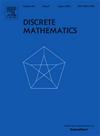On 1-2-3 Conjecture-like problems in 2-edge-coloured graphs
IF 0.7
3区 数学
Q2 MATHEMATICS
引用次数: 0
Abstract
The well-known 1-2-3 Conjecture asks whether almost all graphs can have their edges labelled with so that any two adjacent vertices are distinguished w.r.t. the sums of their incident labels. This conjecture has attracted increasing attention over the last years, with many of its aspects of interest being investigated by several authors. In early 2023, Keusch proposed a full solution to the 1-2-3 Conjecture.
Among other aspects of interest, several works introduced and studied ways of generalising such distinguishing labellings and the 1-2-3 Conjecture to structures more general than graphs, such as digraphs and hypergraphs. In the current work, we introduce two new variants for 2-edge-coloured graphs (having negative and positive edges), in which, through labellings, pairs of adjacent vertices are considered distinguished if and only if the differences between their incident positive and negative sums are different. The difference between the two variants we introduce is that, in one of them, this distinction must be met even when considering the absolute value of these differences.
We investigate how these two variants connect, and how they relate to the original problem. For each of the two variants, we also establish upper bounds on the minimum number of consecutive labels that suffice to design a distinguishing labelling of almost any 2-edge-coloured graph. This leads us to raise some conjectures on this minimum, which, as support, we prove for some families of 2-edge-coloured graphs. We also investigate weaker versions of these conjectures, where one can choose the polarity of the edges.
求助全文
约1分钟内获得全文
求助全文
来源期刊

Discrete Mathematics
数学-数学
CiteScore
1.50
自引率
12.50%
发文量
424
审稿时长
6 months
期刊介绍:
Discrete Mathematics provides a common forum for significant research in many areas of discrete mathematics and combinatorics. Among the fields covered by Discrete Mathematics are graph and hypergraph theory, enumeration, coding theory, block designs, the combinatorics of partially ordered sets, extremal set theory, matroid theory, algebraic combinatorics, discrete geometry, matrices, and discrete probability theory.
Items in the journal include research articles (Contributions or Notes, depending on length) and survey/expository articles (Perspectives). Efforts are made to process the submission of Notes (short articles) quickly. The Perspectives section features expository articles accessible to a broad audience that cast new light or present unifying points of view on well-known or insufficiently-known topics.
 求助内容:
求助内容: 应助结果提醒方式:
应助结果提醒方式:


